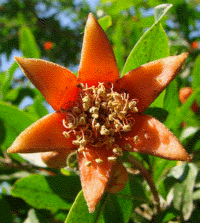 Pomegranate PomegranateThe
word "pomegranate" is from the Latin pomum
("apple") and granatus
("seeded).
 The pomegranate is a
decidous shrub that typically grows 12-16 feet
high, but can reach heights of up to 30 feet. It
has red-brown bark that becomes gray with age,
and stiff, angular branches that are sometimes
spiny. The leaves are glossy and narrow. The
bright red, white, or vaiegated flowers grow
singly or in groups of two or three at the ends
of the branches and have five to eight petals.
Pomegranate flowers can self-pollinate, but
commercial growers often rely on bees to
pollinate their trees. The tree is fairly
reistant to drought and light frost, has few
insect pests, and is quite capable of living for
over 200 years, although fruit production will
typically decline significantly after about 20-30
years. The pomegranate is a
decidous shrub that typically grows 12-16 feet
high, but can reach heights of up to 30 feet. It
has red-brown bark that becomes gray with age,
and stiff, angular branches that are sometimes
spiny. The leaves are glossy and narrow. The
bright red, white, or vaiegated flowers grow
singly or in groups of two or three at the ends
of the branches and have five to eight petals.
Pomegranate flowers can self-pollinate, but
commercial growers often rely on bees to
pollinate their trees. The tree is fairly
reistant to drought and light frost, has few
insect pests, and is quite capable of living for
over 200 years, although fruit production will
typically decline significantly after about 20-30
years.
The fruit of the pomegranate (technically a
berry) is 2-1/2 to 5 inches in diameter and has a
tough, leathery skin that is usually yellowish
with prominent overtones of red or pink.  Each fruit contains up
to 600 seeds, each of which is encased in a pulp
that varies from white to deep red or purple in
color. Each fruit contains up
to 600 seeds, each of which is encased in a pulp
that varies from white to deep red or purple in
color.
The wild pomegranate is native to the Iranian
Plateau and the Himalaya region of India and
Pakistan, but cultivated varities are found
across the Mediterranean region and the Middle
East, into the drier regions of Southeast Asia,
Korea, Japan, and tropical Africa. It was
introduced into Latin America and California by
the Spanish in 1769, but is only cultivated today
in California and Arizona.
Pomegranate seeds can be eaten raw or used as
a spice, and the pulp can be made into a juice or
jam; pomegranate juice is the principal flavoring
in grenadine liqueur. The flowers are also
edible, and most often used like a vegetable. The
seeds are high in dietary fiber, and both seeds
and pulp are good sources of vitamins C and B,
potassium, and antioxidants. The bark of the
pomegranate tree has been used as a traditional
remedy for diarrhea, dysentery, nose bleeds,
hemorrhoids and intestinal parasites since
ancient times, and the juice is an ancient tonic
for heart and throat ailments. Modern science has
found that pomegranate juice can help prevent
heart disease and plaque build-up in arteries.
Scientific Classification
Division Angiosperms
Class Magnoliopsida
Subclass Rosids
Order Myrtales (myrtles, primroses, etc.)
Family Lythraceae (myrtles, etc.)
Genus and species Punica granatum
Questions or comments about
this page?
|



